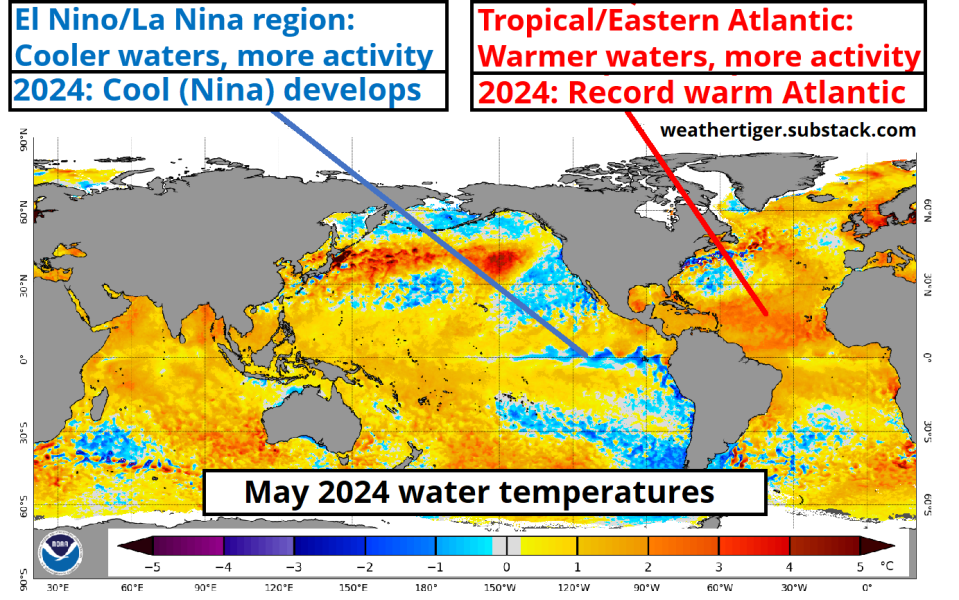Florida hurricane season: 'Berserk' warm waters fuel a truly scary forecast | WeatherTiger
I am not trying to scare you.
I don’t issue seasonal hurricane forecasts for the clicks, the clout, the hearts, or the stars. I have no agenda other than being right and not scaring you unnecessarily.
Unfortunately, while I am not trying to scare you, WeatherTiger’s outlook for the 2024 season is objectively unsettling, especially with the Gulf Coast already brutalized by severe weather in its prologue.
The most likely outcome is overall hurricane activity more than twice that of an average year, with minimal chances of a quiet season and greater than 90% odds of a “hyperactive” year amongst the top dozen since 1950.
Who is WeatherTiger? A veteran Tallahassee-based forecaster
A little about me before we get rolling: I’m Ryan Truchelut, chief meteorologist at WeatherTiger, a Tallahassee-based weather analytics and forensic meteorology firm. I have a doctorate from Florida State and 20 years of forecasting experience, including eight years delivering a signature blend of Florida-focused hurricane analysis plus cringeworthy dad humor for the USA TODAY Florida Network.
This year like years past, you can expect a weekly tropical overview column between June and October, with more frequent forecasts as the situation warrants.
I also enjoy running the hidden pine trails of the forest, tasting the sun-sweet berry flavors of LaCroix, and the riches of dad life with my two kids, whose names are both derived from the 2024 storm list.
I take the tropics seriously.
As part of that commitment to you, I’ve already laid in a stockpile of LaCroix at WeatherTiger World HQ, which working late (because I’m a forecaster) will turn into a mighty pyramid of empty cans by season’s end. It will grow with each forecast, but how high will 2024’s LaCroix ziggurat be?
Let’s unpack that hyperactive forecast like a pallet of naturally essenced sparkling water and translate it into U.S. hurricane landfall odds.
Every reliable predictor, credible organization points to good chance of most aggressive hurricane season on record
Before getting into specifics, note that seasonal outlooks do not “always predict a busy season,” despite the emails after I write this forecast each year to the contrary.
The actual record, not vibes, shows the pre-season outlook consensus has underestimated seasonal activity in five of the last eight years, including 2023. WeatherTiger’s pre-season forecast, as accurate as they come, has undershot three times, missed high once, and been close to correct four times since 2016.
The lone overestimate? The 2022 season, in which Hurricane Ian caused $113 billion in damage and WeatherTiger’s analytics highlighted an elevated chance of Florida landfall threats.
Seasonal forecasts are imperfect, but they have historical skill originating from the persistence of ocean temperature anomalies between spring and hurricane season, influencing how many and where storms develop. Most of the time, these leading indicators present a mixed portrait of the season ahead, as was the case in 2023.
However, WeatherTiger’s March outlook alarmingly showed reliable predictors all signaled a busy year in 2024.
It wasn’t just us. Every credible forecast group, from Colorado State to the European Centre, has since issued their most aggressive spring hurricane season outlooks ever, with most methods calling for around twice average activity.
'Berserk' warm Gulf waters, but don't expect an early start to Florida hurricane season
A forecast for a BOGO hurricane season is an extraordinary claim, and as such, requires extraordinary proof. And, indeed, extraordinary is the word for what is happening with water temperatures in the Atlantic.
The historical relationship between warm anomalies and increased hurricane activity is strongest in a hook across the Tropical and Eastern Atlantic, and it is precisely these regions where ocean warmth is now the most pronounced relative to normal.
Sea surface temperatures in the Atlantic’s Main Development Region are running 3-5 degrees Fahrenheit above 1991-2020 averages, and are as warm today as they typically would be in late August. These warm waters run deep, and there is no sign of a mean reversion. Like Billy Joel, sea surface temperatures are going to extremes in 2024.
You might be wondering why the Atlantic isn’t cranking out hurricanes if water temperatures are already in midseason form. The answer is that atmospheric conditions also matter. Upper-level winds over the Tropical Atlantic have been inconducive (as usual) for tropical development in May, and are likely to remain that way for at least several more weeks.

Elevated wind shear has been spurred by the last gasps of 2023-24 El Ni?o in the Equatorial Pacific, which is linked to unfavorable atmospheric conditions for hurricane development in the western Atlantic.
Unfortunately, El Ni?o met its expected demise a few weeks ago and cool sea surface temperature anomalies are now spreading westward toward the central Equatorial Pacific. In a few months, these cooler waters will likely sync with a symbiotic wind pattern, birthing the fourth La Ni?a event of the past five years.
These La Ni?as are a big part of why hurricane seasons since 2020 have felt punitive.
Years with a peak season La Ni?a tend to have less wind shear over the Gulf, Caribbean, and western Atlantic, and as such, average about twice as many U.S. and Florida(!!!) hurricane landfalls as El Ni?o years. Some ambiguity remains about the eventual strength of the 2024 La Ni?a, but history shows that distinction to be mostly immaterial to landfall risks: weaker or stronger, all flavors of La Ni?a average the same number of U.S. hurricane impacts.

Overall, what little has changed since WeatherTiger’s March outlook has changed for the worse, with less uncertainty in the timing of La Ni?a development and Atlantic sea surface temperatures trending ever more berserk
Forecast calls for 5-8 major hurricanes, at least 2 U.S. landfalls
WeatherTiger’s algorithm quantifies these key predictors to optimize odds of how hurricane season may play out. Of the 11 factors WeatherTiger’s model is currently integrating, a whopping six are strongly positive, with three more favorable, one neutral, and just one weakly negative.
As such, there is a 90-95% chance of a hyperactive hurricane season with at least two-thirds more total tropical activity than normal and a most likely outcome of a little over twice average activity, a 10% increase from WeatherTiger's March forecast.
The 2024 season has a 50-50 shot of landing in the ranges of 22-26 tropical storms, 10-13 hurricanes, and 5-8 major hurricanes.
However, forecasts of Atlantic tropical activity have limited utility in understanding what matters: landfall risks. For instance, storms occurring in the eastern half of the Atlantic have no or even a slight negative correlation with U.S. landfalls, as tropical waves that develop there are more likely to curve north into the open Atlantic.
Even if we knew with metaphysical certitude how much tropical activity would occur this year, that would put us only about one-third of the way to accurately predicting the total severity of U.S. impacts. The rest is determined by where storms develop and how they move. Luck plays a major role, as well.
It isn’t possible to forecast peak season steering currents months ahead of time, but WeatherTiger’s targeted seasonal model for U.S. hurricane landfall risks sifts through subtle signals that separate catastrophic from busy but forgettable years.
For example, the 2010 season was hyperactive in terms of total activity, but a crescent of very cool waters in the northeastern Pacific likely played a role in keeping storms away from the continental U.S. that year — unlike the hyperactive and destructive 2004, 2005, and 2017 seasons.

Right now, our landfall risk model is tilting away from worst-case scenarios, though still projecting an 80% chance of at least two U.S. hurricane landfalls in 2024. That’s above normal, but nowhere near as aggressive as our overall activity guidance.
A final twist to WeatherTiger’s seasonal models is their unique real-time capability. Each day this season, our algorithm will translate a snapshot of the ocean and atmosphere into fresh odds of overall activity and U.S. landfall outcomes.
This served readers well in 2022 and 2023, as our models ably stayed abreast of mid-season forecast swerves in live time. You can check out our updated daily predictions and a more detailed version of this outlook with additional gifs at weathertiger.com.
A 25% chance of the busiest hurricane season in history
In conclusion, the 2024 hurricane season is nearly certain to be more active than average and has a roughly 25% chance of being the busiest on record. Key concerns include deranged Atlantic warmth, conducive upper-level winds, and little chance either will change course over the next three months.
On the plus side, busy seasons sometimes have muted landfall impacts, and the Choco Taco is supposed to return this summer. That’s about it. There’s no normal way to do anything anymore.
So, it’s time to plan for hurricane season.
I’m not trying to scare you, but I am trying to make a rational case for getting ready before the LaCroix cans are stacked as high as an elephant’s eye and things get emotional like a quadruple-length "Bluey" episode.
Since 2017, eight Category 3 or higher U.S. hurricane landfalls have caused a half-trillion dollars of destruction, and we’ll be darned lucky if it doesn’t happen again this year.
Prepare your hurricane kit, know what to do if you receive an evacuation order, and trim those trees if cruel nature hasn’t done it — you’ll be glad you did.
Then crack open a refreshing pamplemousse, limoncello, or razz-cran and settle in, because we’ve got a journey ahead of us.
Keep watching the skies.

Dr. Ryan Truchelut is chief meteorologist at WeatherTiger, a Tallahassee company providing forensic meteorology expert witness services, and agricultural and hurricane forecasting subscriptions. Visit weathertiger.com to read an expanded version of this outlook and discover how to put our expertise to work for you.
This article originally appeared on Tallahassee Democrat: Florida hurricane season forecast: Twice average number of storms